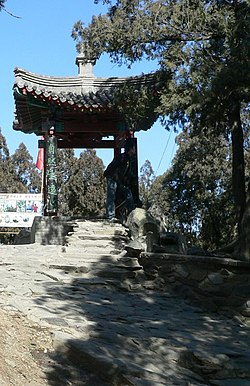Badachu
This articlemay rely excessively on sourcestoo closely associated with the subject,potentially preventing the article from beingverifiableandneutral.(March 2023) |
| Badachu Park | |
|---|---|
 A pavilion in Badachu | |
 | |
| Type | Urban park |
| Location | Beijing,China |
| Area | 332 hectares |
| Created | 7th century |
| Status | Open all year |
TheBadachu(simplified Chinese:Tám đại chỗ;traditional Chinese:Tám đại chỗ;pinyin:bādàchǔ;also known as "Badachu Park" ) is a complex ofmonasterieslocated on the outskirts of urbanBeijing,which means "Eight Great Sites" that refers to the eightBuddhisttemplesandnunneriesscattered across the Cuiwei, Pingpo, and Lushi hills inShijingshan District,at the foot of Beijing'sWestern Hills.[1]Badachu is also famous for its twelve naturally-formed landscapes. As the old saying goes: three mountains are like a beautiful house, eight temples are like an antique in the house, and twelve scenes are like a garden outside the house.
Three Mountains
[edit]The north one is Hutou Mountain( đầu hổ sơn ); the south one is Qinglong Mountain( Thanh Long sơn ), and the middle one is Cuiwei Mountain( Thúy Vi sơn ). The shape of the three mountains is not only like a triangle but also like a road-backed armchair. Cuiwei Mountain is the backrest; Qinglong Hill and Hutou Hill are the armrests.
Cuiwei Mountainis also called Pingpo Mountain. The name of the mountain shows that the mountain's pines and cypresses are evergreens. It is the highest one among the three mountains. It is famous for being the burial place of Princess Cuiwei. The mountain contains five temples, which are Sanshanan Nunnery, Dabei Temple, Longquan Nunnery, Xiangjie Temple, and Baozhu cave.[2]The mountain is the main body of Badachu Park. There is also a yellow beads hole in the mountain.
Hutou Mountainmeans the head of a tiger. That is because the shape of the peak of the mountain is like the head of a tiger and the whole mountain is just like a lying tiger. In the historical record, Hutou Mountain is also called Mingjue Mountain( danh giác sơn ). The mountain has two temples, which are Changan Temple and Lingguang Temple.[2]
Qinglong Mountainmeans green dragon. The shape of the mountain is just like a green dragon circling. The east part of it is also called Lushi Mountain. It is famous for the legend of monk Lu Shi. According to the legend, at the end of the Sui dynasty, Lu Shi tamed two dragons and buried them in the mountain. The mountain also has the ruins of four more temples and a yard. Its cultural heritage is extremely profound. The mountain has one of the Eight Temples, which is Zhengguo Temple.[2]
Visiting
[edit]Visitors can walk from one temple to another, viewing the area's scenery,arbor,and rare ancienttrees.Some of these trees have been standing for over six centuries, but theirrootsand branches are still strong and in good shape. In September and October, when the leaves are turning red, crowds of tourists come to climb the mountains. There is a cable-car to the top of the hill.
Gallery
[edit]-
Treasure trunk pagoda at Lingguang Temple (Lingguangsi)
-
Entrance to the Dabei Temple (Dabeisi)
-
Entrance to the Xiangjie Temple (Xiangjiesi)
-
Paifang at the Baozhu Cave
-
Lingguang Temple, one of the eight monasteries located at Badachu
Notes
[edit]- ^Petra Häring-Kuan, Yu-Chien Kuan (1987).Magnificent China: a guide to its cultural treasures.Joint Publishing.p. 149.ISBN962-04-0566-8.
- ^abc"Tam sơn - Tây Sơn tám đại chỗ phía chính phủ trang web".badachu.cn.Retrieved2021-04-28.





